
NYMPHS & BUZZERS
BACK TO TABLE OF CONTENTS
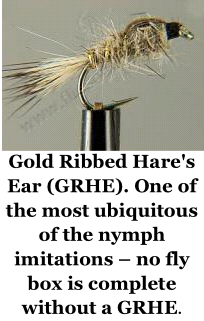
A nymph is the generic term that describes the larval stage of many aquatic creatures. Mayflies, dragonflies, stoneflies, damselflies and many more all go through a stage in their life cycle when they live underwater as a nymph. Also included in this category are other invertebrates, such as coryxa, hoglouse, shrimp and virtually anything else that swims, wriggles or crawls around the bottom of the lake or river. Finally, the pupal stage of many flies are also found in this section. My very first reservoir caught trout, when I had no idea of what I was doing, was taken on a green hog louse imitation that I had allowed to fall to the bottom of the water for no other reason than that I was tired of trying to cast the darned thing and which duly got picked up by a very obliging fish. And the only reason that particular fly was on the end of my line in the first place was because it was one of only three flies that I had purchased in a shop that had even less idea than I did. So my choice of ammunition had been somewhat limited in the first place.
Now to business. This video gives a good idea how to make the hare’s ear nymph.
An ideal way to use this nymph is when sedge are hatching. Starting on the bottom of the lake or reservoir these nymphs are also known as caddis fly. They leave their self made homes and swim up through the water to emerge as the moth like fly with two long antennae. When making this upward journey they look very much like the hare’s ear nymph and this should be used on a floating line in the shallow areas of the water. A slow steady retrieve can bring violent takes!
Another fly that imitates the caddis fly - also known as the sedge - is the Diawl Bach.

The Diawl Bach
This nymph can be fished either on a floating or slow sink line, depending on the circumstances. The ideal depth is ten to twelve feet of water and I would use a floating line in calm conditions or a slow sink line in windier conditions when a possible undertow might hold the leader higher in the water. The slow sink line will pull the flies down with it. No nymph fisherman’s fly box is complete without a selection of Diawl Bachs! Here is Dave Camiss tying one up.
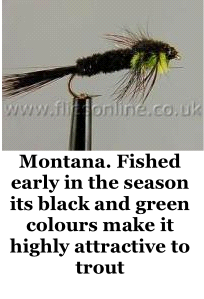 Living among the vegetation or hiding under rocks, many nymphs are surprisingly aggressive and carnivorous, such as the dragonfly nymph, while others are passive and vegetarian, such as the stonefly nymph. Nymphs can live for two years or more in their watery home before emerging above water to metamorphose into their adult counterparts. This means they represent a constant food source for trout and other fish, so nymph imitations must be an important part of the fly fisherman's inventory. Don’t get confused if someone starts talking about naiads – it’s just another name for the nymph of the dragonfly, damselfly, stonefly or mayfly. Here is a lovely video of a nymph tying which really takes the idea of economy of materials to its ultimate!
Living among the vegetation or hiding under rocks, many nymphs are surprisingly aggressive and carnivorous, such as the dragonfly nymph, while others are passive and vegetarian, such as the stonefly nymph. Nymphs can live for two years or more in their watery home before emerging above water to metamorphose into their adult counterparts. This means they represent a constant food source for trout and other fish, so nymph imitations must be an important part of the fly fisherman's inventory. Don’t get confused if someone starts talking about naiads – it’s just another name for the nymph of the dragonfly, damselfly, stonefly or mayfly. Here is a lovely video of a nymph tying which really takes the idea of economy of materials to its ultimate!
As mentioned, other fly varieties choose to employ a pupal stage in their life cycle rather than a nymph stage. These tend to be the smaller fly species, such as midges, mosquitoes and chironomids to name just a few. They start off life after hatching from the egg as a small worm-like creature, later developing into a free swimming pupa before ascending to start their airborne existence. In fly fishing these larvae carry the generic name of buzzer or bloodworm. They are another important food source for fish of all kinds. Indeed, trout can become obsessed with a particular variety if the larva is actively hatching.
 The corresponding fly patterns are many and varied. While some imitations, as with the dry flies, are species specific, many more have become generalised to the point where they are impossible to ascribe to a specific species. For example, a Montana is an example of a general form of a nymph which has no similarity to any creature found in most waters yet is extremely successful all round the world. Equally, a bloodworm buzzer is simply a hook with a bend in its shank dressed with a dark red thread. It is so generic as to resemble virtually any fly larva that goes through a wormlike phase. Here is a fine video of the construction of a holographic buzzer - so named to reflect the material used in the wing cases and ribbing.
The corresponding fly patterns are many and varied. While some imitations, as with the dry flies, are species specific, many more have become generalised to the point where they are impossible to ascribe to a specific species. For example, a Montana is an example of a general form of a nymph which has no similarity to any creature found in most waters yet is extremely successful all round the world. Equally, a bloodworm buzzer is simply a hook with a bend in its shank dressed with a dark red thread. It is so generic as to resemble virtually any fly larva that goes through a wormlike phase. Here is a fine video of the construction of a holographic buzzer - so named to reflect the material used in the wing cases and ribbing.
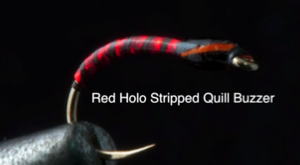
Additionally, there are the other fauna that lives near the bottom and are included in this category, such as shrimps, louse and snails. Many of these creatures will live in the bottom debris of the waters for most of their time, so the imitations of them must be fished at or near the bottom of the water, usually at a slow pace. Indeed, some lake and reservoir fishermen have a good deal of success fishing them static just off the bottom. One old hand used to declare that the retrieve rate for this type of fly should be no more than "an inch an hour"!
There are two ways to achieve this ideal method of fishing near the bottom. Firstly, a slow sink line can be used and the fly line is allowed to sink through the water before the retrieve begins, keeping the flies as close to the bottom as possible. As described elsewhere, this entails a good knowledge of the sink rate of your fly line, the depth of water you are fishing and how long your cast should take to be retrieved - the further you cast, the longer it will take to retrieve it. An error in calculating this will result in your fly hitting the bottom and either snagging or being smothered in bottom mud, weed, slime, etc. Having said that, it is not really very hard to work out this timing using trial and error. I advocate this counting system because I believe it adds to the fun and interest if you adopt a more scientific approach to your sport - and you'll certainly catch more fish.
 The second way of presenting a nymph at depth is with the use of a floating line and a leader of sufficient length so that the fly hangs down through the water and hovers just off the bottom. This technique demands a much more accurate knowledge of the depth of water you are fishing. Too long a leader and your fly will simply rest on the bottom, lost among the rest of the debris down there. Get it right and the takes are strong and confident as the fish find a juicy nymph swimming near the bottom - which is exactly where they would expect to find it. I have used this technique with success in depths of twenty feet and more.
The second way of presenting a nymph at depth is with the use of a floating line and a leader of sufficient length so that the fly hangs down through the water and hovers just off the bottom. This technique demands a much more accurate knowledge of the depth of water you are fishing. Too long a leader and your fly will simply rest on the bottom, lost among the rest of the debris down there. Get it right and the takes are strong and confident as the fish find a juicy nymph swimming near the bottom - which is exactly where they would expect to find it. I have used this technique with success in depths of twenty feet and more.
This video shows the Czech nymph’s construction.
In flowing water, extra weight is added when tying the fly to keep it near the bottom. This can be done by adding a weighted bead at the head of the fly, as in the gold heads, or by wrapping the shank of the hook with lead wire, such as with the Czech nymph.
When you’ve tied the Czech nymph, this video will show you how to use it!
This video demonstrates the short line nymphing method.
The challenge of assessing the depth in still water can be overcome with the use of a fish finder if you can afford one (and if they are permitted on the water), or else with the use of a plumb weight. Attach it to your line and with a little trial and error you can find the point at which the floating line stops being dragged under. Some anglers also use a sight bob at the end of their floating line to help in keeping everything in the right place. Attached to the braided loop at the point where the leader starts, it acts rather like a float in coarse fishing and for that reason some purists eschew them.
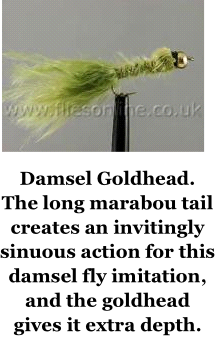 The other way to achieve the advantage of a sight bob is to use a floating or bushy dry fly as the top dropper. This system works well when fishing in relatively shallow water, otherwise the weight of the long leader can drag the dry fly under. The short piece of line used to make the dropper is not used in this system. Rather, the leader runs from the main line to the bushy dry fly and the second length of leader is tied from the bend of the hook in the dry fly to the eye of the hook in the nymph. This gives a direct link from dry fly to nymph, which would not be possible if a dropper was being used. Any takes on the nymph will be immediately transmitted to the dry fly and are identified as the dry fly is dragged underwater. Of course, none of this accurate depth fishing applies if you are fishing a stream or river. There the challenge is to get the nymph down near the bottom before your line gets washed downstream. Knowing the depth of your moving water is necessary to give you an idea of what you are dealing with and that should be relatively easy to assess. Then it is a matter of ensuring your fly has sufficient leader and weight to get the job done.
The other way to achieve the advantage of a sight bob is to use a floating or bushy dry fly as the top dropper. This system works well when fishing in relatively shallow water, otherwise the weight of the long leader can drag the dry fly under. The short piece of line used to make the dropper is not used in this system. Rather, the leader runs from the main line to the bushy dry fly and the second length of leader is tied from the bend of the hook in the dry fly to the eye of the hook in the nymph. This gives a direct link from dry fly to nymph, which would not be possible if a dropper was being used. Any takes on the nymph will be immediately transmitted to the dry fly and are identified as the dry fly is dragged underwater. Of course, none of this accurate depth fishing applies if you are fishing a stream or river. There the challenge is to get the nymph down near the bottom before your line gets washed downstream. Knowing the depth of your moving water is necessary to give you an idea of what you are dealing with and that should be relatively easy to assess. Then it is a matter of ensuring your fly has sufficient leader and weight to get the job done.
The technique for fishing a nymph in flowing water is to cast upstream and across the flow, mending the line and allowing the line to carry downstream as the flies sink. Any unnatural movement of the line may indicate a take and should be struck without delay. A site bob is used by some to aid in bite detection. Alternatively, the sink and draw method, whereby the flies are lifted and allowed to fall several times as they move downstream can be very effective. Either way, the best method is to approach from downstream and work your way up the river, creating less disturbance to your quarry as you approach from behind – remember, fish face upstream to take advantage of the current. This video shows how this system works.
Many nymph type flies are now tied with a bead at the head. These beads come in all materials and colours, from gold to tungsten and from silver to black. This adds to the weight of the fly and aids in quickly sinking the fly to the right depth. It will also act as a strike point for the fish. I have added gold beads to just about every nymph I have tied as an alternative variation. Use a standard tying of the fly on the dropper and a gold head variation on the point to keep the leader separated during casting - the weight of the gold head means that it will fly first, just where you want it.
Some nymphs are tied with additional weight in the form of lead or other wiring in their construction to take this idea of additional weight even further. This will keep the fly at depth even when fishing in fast running water. This lead can be wound round the shank after laying down the first layer of thread or strips can be added down the sides of the shank and held in place with a rib of thread. This method gives more width to the fly - useful when imitating some of the larger nymphs such as the stonefly.
Here’s a video showing a nice easy way to tie a damsel fly nymph.
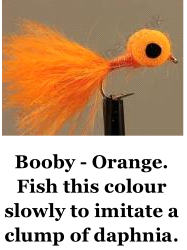 All of the foregoing comments apply equally to buzzer fishing and the techniques work just as well. There is, however, one other method that can be used when buzzer fishing, that does not lend itself to fishing a weighted nymph. This is because buzzers can be made smaller and lighter, which is a requirement in the following technique. Using a large booby, razzler - or similar fly with a high buoyancy - as a floatation aid, a buzzer is then attached to the leader on a very short dropper. The idea is that the booby will sit close to the bottom when the hi-d line has settled. The buzzer will then hang down and hover just off the bottom, just where a foraging trout would expect to find it. They will frequently ignore the booby in favour of the smaller buzzer, which can demonstrate their tendency to concentrate solely on one food item at certain times. This technique should be fished static or with an extremely slow retrieve, otherwise the buzzer will be dragged into the bottom detritus.
All of the foregoing comments apply equally to buzzer fishing and the techniques work just as well. There is, however, one other method that can be used when buzzer fishing, that does not lend itself to fishing a weighted nymph. This is because buzzers can be made smaller and lighter, which is a requirement in the following technique. Using a large booby, razzler - or similar fly with a high buoyancy - as a floatation aid, a buzzer is then attached to the leader on a very short dropper. The idea is that the booby will sit close to the bottom when the hi-d line has settled. The buzzer will then hang down and hover just off the bottom, just where a foraging trout would expect to find it. They will frequently ignore the booby in favour of the smaller buzzer, which can demonstrate their tendency to concentrate solely on one food item at certain times. This technique should be fished static or with an extremely slow retrieve, otherwise the buzzer will be dragged into the bottom detritus.
Finally there is the booby. I have included it in this section because it is primarily designed to emulate a nymph, although it is now widely used as a lure when the trout are fry feeding. I have described the methods of booby fishing in detail elsewhere so I will not repeat it here. Suffice to say – if the fish are feeding at depth then the booby may be the ideal weapon of choice. Colour can be very important with the booby – each colour offering a simulation of a different prey species. White can be an injured fry, brown a dragonfly nymph, orange a clump of daphnia and so on.
David Cammiss has put together a fine website showing how to tie a number of flies. He has kindly allowed me to incorporate his videos into this book - which means I don’t have to reinvent the wheel! This is a nice video showing David tying up the Copper Nymph:
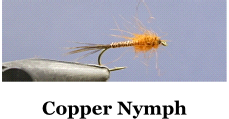
This one is called the Green Beast which definitely looks like a damsel nymph imitation:
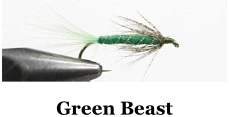
This is the Jersey Herd named from the gold foil that was used for its body when first invented in the seventies. The foil came from a milk bottle top! This is another nymph imitation.

This video is a good representation for the stonefly - and hence its name of the Dark Stonefly!

This video is another nymph - this one is called the Prince Nymph.
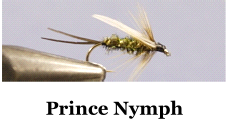
This video is a new take on the buzzer, the Taser Bug was originally constructed using the wire from a spent taser gun! I don’t advocate causing a disturbance in the hope that you’ll get tased just to get your hands on some of this material - Dave has a better solution!
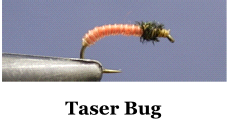
Here is Dave’s take on the Booby.
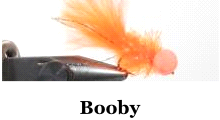
Another take on the booby.
This is the Cormorant which is used primarily on still waters although it can be tried on rivers. Variations include holographic or silver bodies.

The Stickfly is an imitation of the caddis grub in its case. The caddis metamorphoses into the sedge and this fly is popular on still waters.
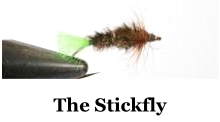
The Montana, as its name implies originated in America where it was used as a stonefly nymph imitation. It has now become a generic fly for any nymph fishing.
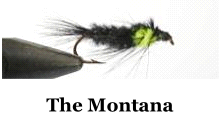
Of course, no fly tying exercise would be complete without the buzzer - and here it is! This one is Dave Cammiss’s method and shows us just how easy it is.

And Dave shows how he creates the Pheasant Tail Nymph. As always you can experiment with the basic pattern, for example changing the colour of the head.
Here’s another take on the Pheasant Tail Nymph (PTN)
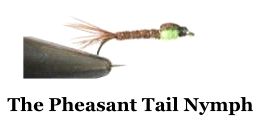
Another staple of the nymph fly box is the Gold Ribbed Hare’s Ear. This is Dave’s directions for its creation.

And finally, another suggestion for the Gold Ribbed Hare’s Ear.